BATTLEGROUND ANTARCTICA
Revealed: Inside Antarctica’s brutal, lingering noise war on marine life (Part Two)
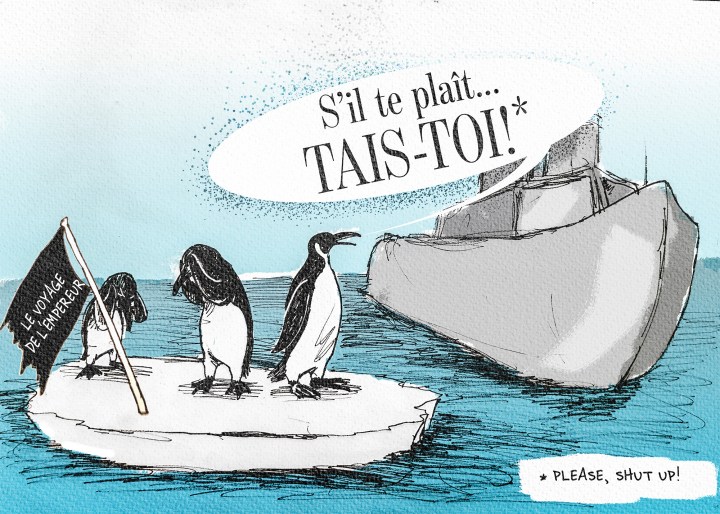
In Part One of this investigation, Our Burning Planet charted the human noise pollution that may be hounding life inside the Southern Ocean, a climate-threatened wilderness ruled by a guarded club of geopolitical power players. In this sequel, we expose the yearslong failure by Antarctic states to stop the ongoing suffering that may be experienced by an array of vulnerable species.
For nearly 25 years, an exclusive network of states obliged to protect a globally pivotal marine wilderness for “peace” and “science” has known about the noise wars that seem to be raging in its waters. These are the icy seas that swirl around Antarctica, and they are as remote and hostile as it gets in our corner of the universe — even so, the Southern Ocean has the pivotal function of connecting all major oceans, and regulating the planet’s atmosphere.
As the first part of this series notes on a frontier-breaking review study about Antarctic marine noise, led by Curtin University in Perth, sound is how the inky ocean sees. Reading the undersea terrain through a dictionary of natural sound, the Southern Ocean’s species rely on their auditory organs for their very survival — after all, marine acoustics allow them to feed, navigate, avoid hazards, track down mates and more.
Yet, acoustic instruments used in marine research, and noise from tourist vessels, among other sources, may be harassing, deafening, injuring and even killing a unique assemblage of marine species — such as seafloor creatures, critically endangered blue whales and existentially threatened emperor penguins.
Fisheries, including krill vessels regulated through the Commission for the Conservation of Antarctic Marine Living Resources (CCAMLR), are also to blame, says the review study. Published in a policy-information portal managed by the Scientific Committee on Antarctic Research (SCAR), this first-of-a-kind study represents a range of findings on noise impacts across species in the Southern Ocean.
The responsibility for addressing all this sonic distress lies at the doorstep of the Antarctic Treaty System (ATS). This is the 55-state governing body that for decades has sanctioned these activities for “peaceful” and “scientific” purposes under the CAMLR Convention, as well as environmental laws such as the 1998 Madrid Protocol.
And though these heavyweight polar states — which include the likes of China, France, Russia, South Africa, the UK and the US — have yet to adopt “breakthrough” action on marine noise, they remain as guarded about their governance decisions as they seem unable to address Antarctica’s most immediate ecological migraines, experts say.
The Antarctic and her vulnerable marine ecosystems — contained in a region melting at an average rate of 150 billion tonnes a year — are already challenged by stressed immunity. But, this summer, noisy sightseers emerging from the pandemic pause are set to converge on this ocean in dramatic numbers — threatening to surge through a record 100,000 visitors for the first time in a single season.
All the while, whole Antarctic ecosystems may be affected— especially right now, as the world’s ships descend on this noise-sensitive wilderness for a summer of field research, fishing and bucket-list adventures.
Indeed, the chilly Southern Ocean’s abyssal depths, reaching more than 7km in parts, spread the low-frequency sound waves of airguns so efficiently that noise “may propagate over long ranges”, cautions the review study.
In other words — human noise pollution in the extreme south can travel over a range of “hundreds-thousands of kilometres”.
Quiet vessels, with a catch?
Southern Ocean scientists are concerned with a vast body of marine research. For some, these investigations include seismic cruises over astonishing distances that rely on the low-frequency blasts of airguns to gather data for — among others — UN climate reports and seabed geological histories. More controversially, airguns are also deployed for dual-use purposes to analyse these heating waters for potential supermassive oilfields — as exposed by a series of Our Burning Planet investigations into Russian Antarctic activities taking place via Cape Town port.
At less than 1,000 Hertz, low frequencies also mask sounds made by many marine mammals, such as whales. It is the maritime equivalent of constantly interrupting life-critical conversations.
In attempts to soften noise impacts in the Southern Ocean, however, some ATS member states claim to apply “exclusion zones”, “soft starts” and other methods under their own national laws.
The latest research vessels may also incorporate advanced noise-reduction technology: the UK’s RRS Sir David Attenborough, for example, and her predecessor, Ukraine’s Noosfera, have quieter propellers.
The UK’s brand-new polar research vessel left the British Isles in late November on her second annual research cruise, set to last about six months. The Noosfera — unable to return to the war-torn port of Odesa — is due to head back to the Southern Ocean this December after anchoring in Cape Town since May.
Expected to call back at Cape Town before Christmas, Germany’s seismic icebreaker Polarstern has already spent several research weeks in the Antarctic since the start of summer.
This vessel features a number of mitigation attempts: including an early-detection programme that tries to spot fauna within a 500m “exclusion zone”. When marine life is identified, the seismic lab can be told to switch off or reduce the airguns, which go Knall! every 11 seconds when in operation.
Some states, such as Australia, use soft starts that gradually ramp up noise to “full power operating level” — that is, they report, “the minimum acoustic energy output that is necessary to achieve the survey’s objectives”. These methods echo those employed by, among others, oil giant Shell’s controversial but currently suspended seismic surveys off the Wild Coast, which have ignited protests across South Africa.
Certain national regulators for ATS member states might also apply their own environmental impact assessments (EIAs), advises Dr Ricardo Roura, a governance expert with the Antarctic and Southern Ocean Coalition (ASOC), a non-profit group.
But here EIAs are likely to be compromised by persistent data gaps — of which there are many in our understanding of noise pollution in the faraway Southern Ocean.
And mitigation measures, including those widely championed soft starts, appear — at best — to offer mixed results.
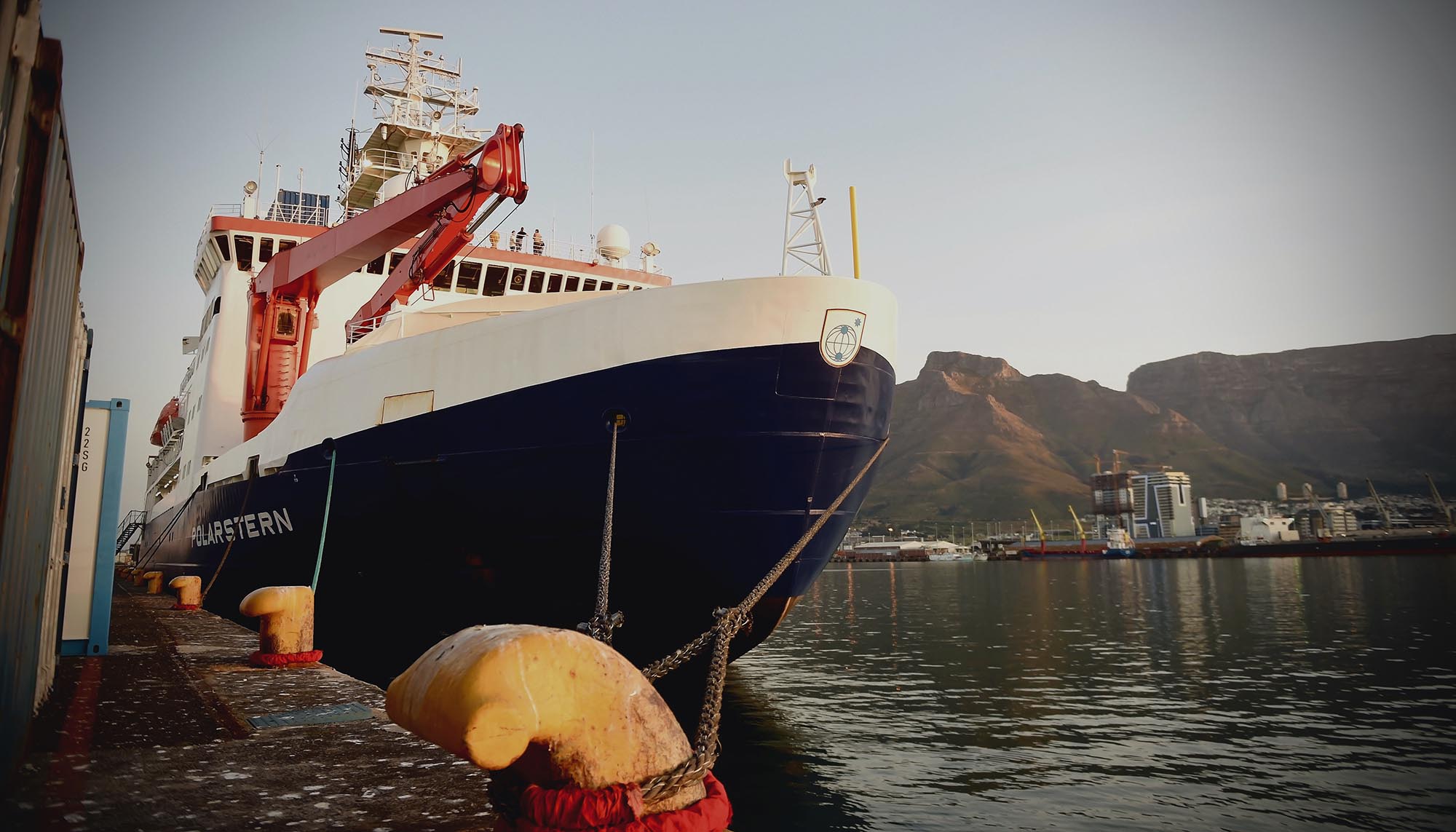
The German seismic icebreaker Polarstern visited Cape Town in October en route to the Southern Ocean. This vessel is expected to call back at the port city, an official Antarctic gateway, before Christmas. (Photo: Xabiso Mkhabela)
‘Little evidence’ of risk reduction
This is because the noise particle, and its metastasising noise particle friends, are a merry band of aggressors that live their best lives in amplification channels closer to the surface in cold-water conditions.
In these water slides, noise becomes like the hagfish slime of the sonic world, hunting down marine life that may be fleeing ramped-up soft starts.
“There is very little evidence that soft starts for seismic surveys are effective at reducing injury, and they do nothing to reduce disturbance,” says Russell Leaper, a whale and acoustics expert with the International Fund for Animal Welfare (IFAW). Leaper has co-written several papers on mitigation measures.
As the review study puts it, “Animals choose habitats for specific reasons and there may not be suitable alternatives.” In summer, for instance, whales voyage thousands of nautical miles from the tropics to feed in Southern Ocean habitats: the largest marine mammal feeding grounds on Earth.
And for their part, human observers or acoustic sensors trying to detect nearby marine life can “only address the risk of injury and not disturbance; and have been shown to be able to achieve a very limited reduction in injury risk, even under ideal circumstances”, Leaper points out.
“Most national guidelines for seismic surveys require operators to use the minimum source levels needed,” he says. “But there is almost no enforcement of this, and regulators rarely ask operators to provide evidence that they needed to use sources of the intensity that was used.
“Thus, the mitigation measures for most seismic surveys in the Southern Ocean are largely ineffective.”
For Leaper, data gaps ought not to stand in the way of solutions. Marine vibroseis arrays, for instance, are a developing technology that beams controllable, likely more benign, acoustic signals through vibrating plates or shells.
“Source levels could be reduced while still using airguns — through careful configuration of the array — as well as completely different technologies such as marine vibrators,” he insists.
“Marine vibrators have been shown to be effective and can both reduce the unwanted frequencies in the signals and allow source levels to be adjusted to suit conditions.”
Meanwhile, more unorthodox remedies have been floated.
At 1990s US public hearings on a $35-million, military-backed climate project that ended up firing low frequencies across the oceans in the decade to 2006, one Martha van Dyke stepped forward to have her say.
“If this sound project is allowed to be put into effect any place in the ocean,” Van Dyke proffered, “then it should be required that every person involved have implanted in their bodies a device that will emit an equal amount of noise.”
Visit Daily Maverick’s home page for more news, analysis and investigations
Deafening silence
Curtin University’s Professor Christine Erbe, the international review study’s lead author, insists that governments and industries see possible noise impacts on Antarctic marine life as “a risk” — “not just to the environment of course, but also to their social licence to operate”.
Erbe says “effort is split across developing a deeper understanding of the problem, mitigating and finding alternatives … There have been numerous efforts looking at alternative sources.”
“Softening the source, timing operations outside critical seasons, employing mitigation and observation zones; and stopping if animals are near” were all potential solutions, Erbe told us by email. Options to reduce impacts are also outlined in the review study.
An authority in underwater acoustics, Erbe argues there are no ideal solutions, but cautions, in bold, that better alternatives might yet become available: “There are limitations as to how quiet you can make a source before it becomes unfit for purpose … at this moment.”
Indeed — even as multilateral institutions have vigorously investigated noise alternatives in other parts of the global ocean — comparatively little will appears to have driven similar, if secretive, ATS annual meetings for nearly 25 years.
For a full 10 years between 2008 and 2018, mostly a deafening silence reigned at such meetings, where Germany was consistently the only ATS member among tens of world powers to raise noise trauma and stress, lead research and fund conferences.
In 2011, an irritated Russian delegation went so far as to claim “this topic had been fully explored at previous meetings”.
Science expeditions in the Southern Ocean, and possibly more noise stress, would persist — yet general discussions of the problem did not even crack the agenda across a full three years of annual meetings between 2013, 2014 and 2015, as reports published after the gatherings show.
Where lone voices raised the impacts of noise, discussions were cloaked in secrecy.
Thus, behind an ice curtain of traditional closed-door talks where the prying eyes of media and most civil society were, and largely continue to be, verboten.
SCAR wars
A particularly revealing “information paper” tabled by Germany at this year’s ATS annual meeting in Berlin — all media were banned from the two-week event — claims “concern” about potential noise pollution in the Southern Ocean was “first raised” at the Hague annual meeting, September 2000.
But that document — the German delegation’s so-called “Information Paper 38” — does not hint at the scientific tensions that had already started roiling on the Pacific shores of the Japanese capital some months before.
Information Paper 38, as tabled by the German delegation at the Berlin meeting.
That Tokyo science event was hosted in July 2000 by SCAR, the most senior committee of polar scientists providing independent advice to the ATS since the late 1950s.
In minutes to one of the Tokyo meetings, it emerged just how much Germany’s federal environment agency appeared to have annoyed working groups of geologists, solid-earth geophysicists and biologists.
The central authority that approves — or denies — German activities in the Antarctic, the agency had demanded stricter, even unreasonable, EIAs of what were simply “standard” seismic and acoustic devices, the minutes argued.
“This decision cancelled major marine science programmes in the Antarctic including a joint German/Italian geophysical survey,” carped a separate set of Tokyo minutes, recorded by the solid-earth geophysicists. “The decision effectively prevents German research into climate change and marine geology as well as fish and krill populations.”
The SCAR scientists vowed to object to the German state.
At the follow-up Hague meeting in September, the scientists would also slate Germany’s “concerns” as “overstated” — fretting that, based “on available evidence … future marine work in the Southern Ocean could be severely impeded if these restrictive positions prevail”.
And though these scientists agreed to investigate noise pollution “as soon as practicable”, the 62-page draft report issuing from their subsequent Cambridge brainstorm — convened in 2001 — is an imprecise document riddled with spelling errors.
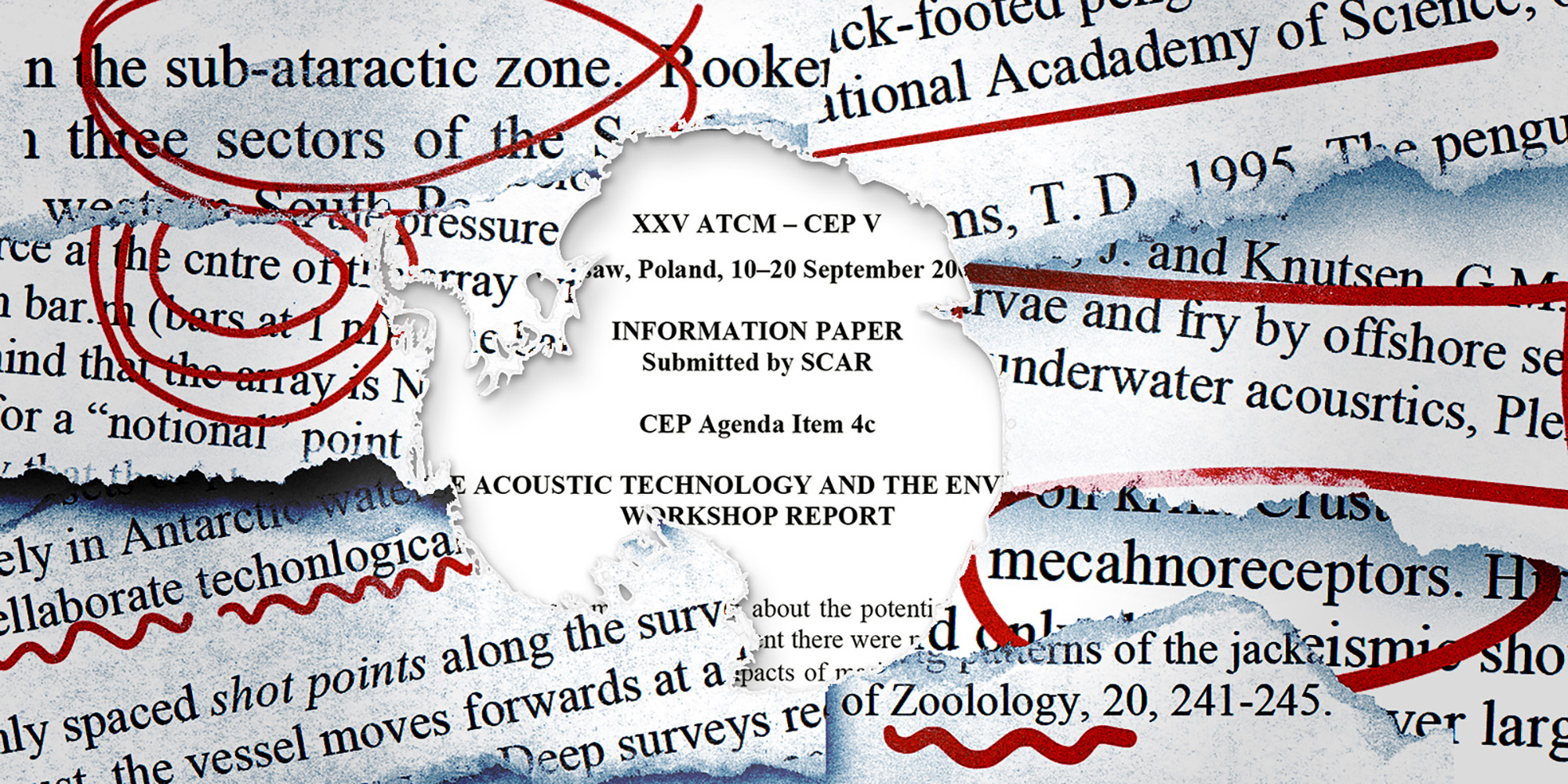
Uploaded to the Antarctic Treaty database, SCAR’s 2002 draft findings on acoustic technology. (Graphic: Righard Kapp)
Submitted to the ATS, this report also appears to rank scientific interest over the precautionary principle — the universally accepted decision-making tool that urges proceeding with prudent caution when faced with uncertainty about the details of an ecological hazard, especially an irreversible one.
Lukewarm about proposing solutions, and further investigations, the Cambridge brainstorm concluded there was “insufficient evidence to justify a ban on marine acoustic technology in the Antarctic particularly given the importance of such equipment in marine research”.
‘Potentially misleading’
At a Warsaw meeting the following year, in 2002, Germany hit back.
“The SCAR report was not in all instances balanced,” the delegation noted, according to the Warsaw minutes. “Some findings in the report were potentially misleading.”
And it was at yet another annual meeting, in 2003, that a report by ASOC — the ATS non-profit environmental observers — would cite noise pollution known decades before.
“Severe problems” occurred when “marine fish were exposed to sound-pressure levels 40 to 50 decibels above that in their normal environment”, the observers said, quoting research harking all the way back to 1973.
Their analysis also described “mass strandings” involving “multiple” cetacean species, “and in at least one instance, the disappearance of an entire local population of Cuvier’s beaked whales”.
At Spain’s Canary Islands, scientists had done autopsies on 10 beaked whales.
They had found “internal haemorrhages in these bodies as well as other signs corresponding to an acoustic trauma harmful pattern”, reported a Spanish ATS paper, tabled at the same 2003 annual meeting.
Beaked whales, though shy, are thought to roam waters right around Antarctica.
Mind the gaps in knowledge
A quarter of a century since noise first edged onto the ATS agenda — some records date back to 1999 — these nascent scientific deliberations should surely have been despatched to the watery grave of history by now. After all, the Madrid Protocol, and parallel agreements, have always been intended to stand sentinel to the environment below 60°S, the line of latitude that girds the Antarctic.
But with no precautionary freeze in sight, at least half a million tourists may now thud into the region over the next five years.
And noise literature on the world’s most studied wilderness, which yearly attracts more scientific brain power than any other refuge on the planet, continues to reveal itself as a paean to a dominant meme: significant gaps in scientific knowledge.
That meme ricochets throughout meeting and scientific reports like airgun pulses.
As Erbe and co-authors stress in a 2019 companion paper on noise and Southern Ocean marine mammals, the Antarctic is an “unusual” sort of laboratory that yields a sea of complex gaps in knowledge. Antarctic fish and diving birds are mostly poorly understood — despite new findings lately offering better clues, such as studies suggesting that gentoo penguins and plummeting African penguins are also sensitive to noise. Another Antarctic unknown is how ice melt might change the spread of noise, for better or worse. And so on.
Yet, though the details remain uncertain of exactly when noise becomes intolerable, here is what the specialists generally do agree on: noise’s harm is well-known, and it is one of the worst types of pollution humans have inflicted on the global ocean’s intricately connected ecosystem. They also agree that any noise addition degrades a habitat to some extent.
For instance, a new study by the Alfred Wegener Institute (AWI), Germany’s top polar research body, shows that even seafloor life without “actual organs for hearing” can be agitated by low frequencies.
And Germany’s Information Paper 38 — that revealing report tabled in Berlin this year — goes so far as to admit that “the state of knowledge of potential impacts on cetaceans (and marine mammals in general) and the understanding of the sources and types of anthropogenic noise present in Antarctic marine waters is fair to good”.
‘Mining conflicts’
Perhaps to explain the persistent delays, Information Paper 38 flags the other 40-odd member states signed up to the Committee for Environmental Protection — the ATS’s conservation advisor — for failing to discuss the issue during lingering interludes. (This committee meets every year and has the power to make conservation laws.)
But perhaps this apparent oversight may be explained by the conservation advisor’s 2014 request to SCAR, when it asked the scientific committee to deliver an underwater noise “update”.
“Delayed” by several years — as the scientific committee would have to admit in a 2018 information paper — it finally put an analysis of some 135 peer-reviewed papers on species and acoustics across the world before the conservation advisor at the Prague annual meeting, in 2019. This included a granular set of professionalised recommendations for the Southern Ocean, including isolating sound-sensitive species and doing an audit of ship density.
Approved by the conservation advisor, and spearheaded by new leadership under SCAR, this was an ambitious update aiming to grasp how an entire ocean ecosystem listens to us humans.
If anything, it shows that the demands required to address noise at the southern ends of the Earth are nothing short of staggering — making the low priority given this issue over many years even harder to fathom.
But a former scientific advisor to a government told us that “mining” and geology conflicts of interest had considerably distorted the advice given by fellow advisors.
“Some geologists thought they should be allowed to do as many seismic surveys as they wanted in this sensitive habitat,” reveals the former consultant, speaking anonymously to discuss sensitive information.
“All other ‘independent’ scientific experts had a background in mining. There was so much conflict, they got rid of all of us and appointed a new group, which only partially solved the issue.”
‘It just takes time’
This brings us right up to 2022 — to the year that the ATS would wrap its annual meeting in Berlin. And to the year that noise pollution was still clunking along as a second-tier priority in the conservation advisor’s work plan.
“It is still unresolved which noise exposure limits and noise mitigation measures need to be used for Antarctic marine mammals and birds,” Information Paper 38 says. And “no specific guidelines for noise production in Antarctica” had actually ever been established, the German delegation had to remind everyone at the 2019 Prague meeting. There is also “no one standard” on how to evaluate activities under the Madrid Protocol, the information paper adds. That lack of progress is echoed by the review study, which concludes that “a more unified approach” to noise management “is needed”.
Information Paper 38 swears German state-funded research is now attempting to finalise thresholds for “harassment” and “auditory injury”.
And “auditory injury” — as the information paper defines it — is decidedly more acute than hearing loss. It is, in fact, “significant damage to the physical integrity or health of an animal”.
Germany’s state-funded recommendations towards “an underwater noise protection concept for Antarctica” would finally be tabled by year end, Information Paper 38 promises, and at the 2023 ATS annual meeting in Helsinki.
“Several of the research recommendations are being addressed,” Erbe urges. “It just takes time and is expensive in such remote locations.”
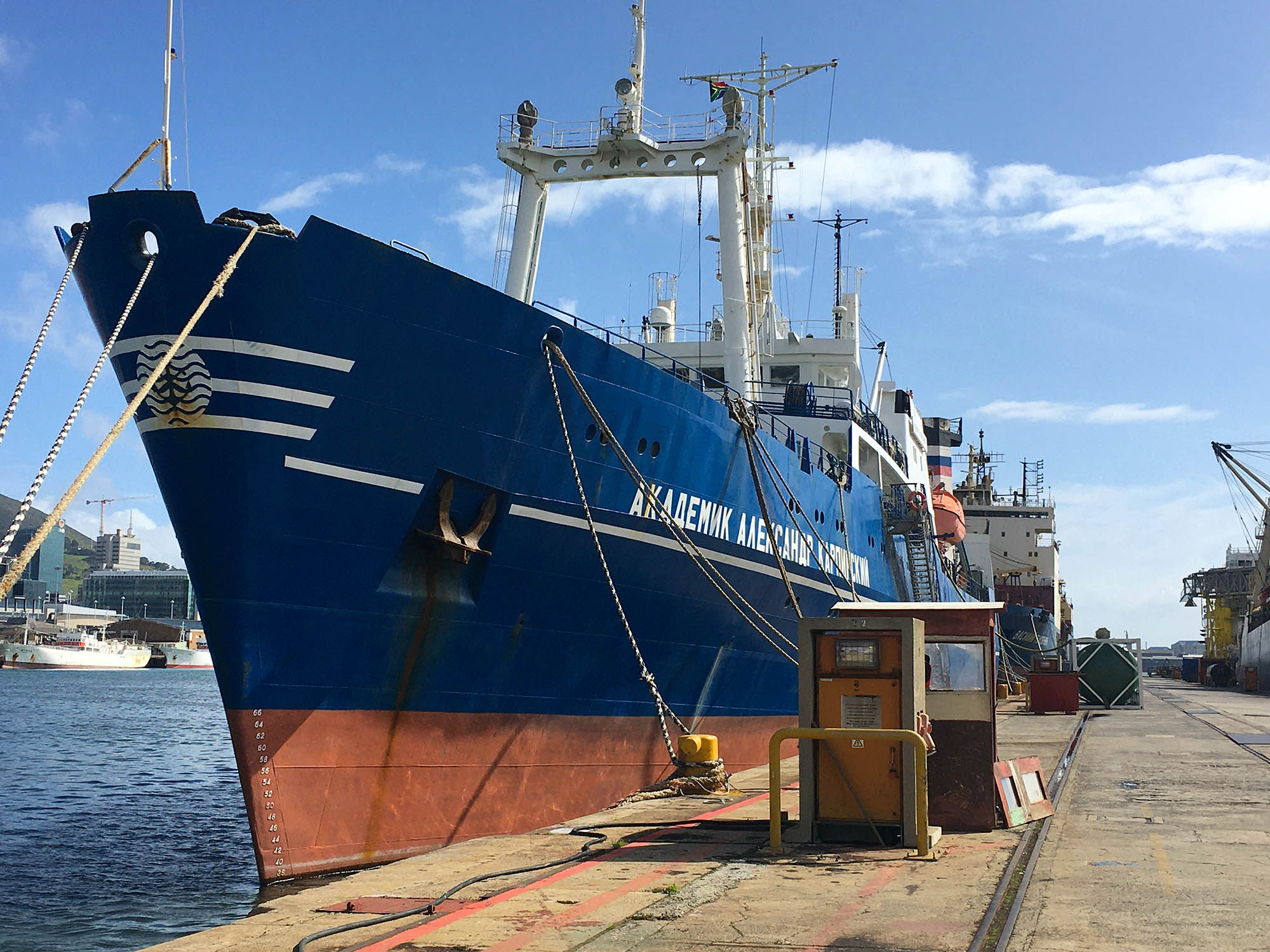
The Akademik Alexander Karpinsky — the seismic vessel that has conducted most of Russia’s Antarctic oil and gas seismic surveys — in Cape Town port, August 2020. (Photo: Tiara Walters)
ATS authorities and Germany’s federal environment agency did not respond to Our Burning Planet’s comment requests. AWI, the German polar research body, declined to answer our questions, issuing a public statement on Polarstern’s achievements instead.
When asked about researchers’ environmental responsibilities under the Madrid Protocol, SCAR instead cited its 2019 literature review tabled in Prague — the one flagging how many data gaps are still to be conquered.
In an emailed response, the International Association of Antarctica Tour Operators (IAATO) was keen to stress its members were responsible environmental custodians.
Communications director Hayley Collings emphasised that IAATO operators have “supported” a variety of environmental initiatives “for decades” — and she highlighted their efforts “to carry trained marine mammal observers or researchers”; as well as “operate within the parameters of the ATS” and other international laws.
According to Collings, “parameters include a necessity by the parties to assess all human activity in Antarctica, including tourism, for their impact on the environment before being authorised to proceed”.
No ‘breakthrough’
“Noise pollution has been discussed on and off at Antarctic Treaty meetings over the past 20-plus years,” confirms Roura, the governance advisor to ASOC, the non-profit observers.
“Acoustic impacts sometimes appear in environmental impact assessments under the protocol, or in exchange of information reporting,” Roura says. He also recognises the German government for “doing some important work recently”.
But he points out, “there hasn’t been a breakthrough yet”.
Such a breakthrough may have to come from outside the ATS, suggests ASOC shipping advisor Dr Sian Prior.
The International Maritime Organisation (IMO), the UN agency tasked with limiting shipping pollution, is now reviewing non-binding noise guidelines adopted in 2014. These are due for their own update next year.
Non-profit groups are also calling for binding regulations supported by UN states such as France, says Prior. And that is just as well, because IMO guideline uptake has been “very poor”.
‘Deadly combination’
Dr Alan D. Hemmings, an Antarctic governance professor at the University of Canterbury in New Zealand, says “the failure of the ATS to adopt any substantive response to the problem of acoustic impacts on marine life — and marine mammals in particular — reflects at least three enduring problems.
“Firstly, everywhere environmental standards and expectations are far lower in the marine environment — even for ‘charismatic megafauna’ such as seals and whales — than they are ashore.
“Secondly, the strongest obligations to avoid harmful interference with animals are found under the Madrid Protocol,” he says, “whereas mammals at sea are essentially left to the tender mercies of CCAMLR and the International Whaling Commission, where no such duties are operationalised.”
Hemmings, who was not involved in the review study, also flags failures by the ATS to live up to its conservation promises. In early November, for instance, CCAMLR failed for a sixth year to declare marine parks.
CCAMLR science manager Dr Steve Parker told us “the issue” of human-caused noise effects on marine life “is complex”.
According to Parker, “the typical focus” is “the effects of seismic surveys and military operations on marine mammals and therefore much less information is available on the effects of sonars used for navigation or fish detection by fishing vessels”.
Parker says permits for fishing and research vessels operating in the Southern Ocean “are managed by individual members”. They are intended “to be consistent with CCAMLR conservation measures and ATS measures. These permits consider the effects of all operations on marine life and can include mitigation requirements as agreed by the members”.
Noise caused by fishing vessels, Parker concedes, “has not been formally raised by members at CCAMLR”. ATS annual meetings and other bodies, such as the International Whaling Commission, would “most likely” table these issues instead, he says.
Parker also cites SCAR’s 2006 noise workshop, which was on CCAMLR’s meeting agenda that year, and reported by the ATS conservation advisor. At that workshop, he says, delegates “suggested the need for a noise map of the Southern Ocean to evaluate the potential for effects of anthropogenic noise”.
Hemmings, the governance professor, adds that, “even in relation to the Madrid Protocol, we have not adopted any legally binding measure on anything, apart from protected areas, since 2009. It is a literally deadly combination, now compounded by the stresses introduced into the Antarctic system — as everywhere else — by Russia’s invasion of Ukraine.”
In this webinar recording, reporter Tiara Walters, Antarctic geopolitics specialist Mikaa Mered and leading environment lawyer Cormac Cullinan unpack the guarded world of Antarctic diplomacy.
Time and tide Thwaites for no one
So, enforceable pain relief for the Southern Ocean’s residents may not be forthcoming in the “short-term”.
Here, we are just paraphrasing Information Paper 38. The only apparent guarantee?
Another year of technical updates seems to be in store for stressed species paying a high price to humans who wish to admire their natural habitat. Or, gain insights into how our 300,000-year-old species may be assaulting a wilderness we have visited only about 200 years.
And should those in charge drag their snow boots, say, another 20 years or so, debates about Antarctic noise pollution may pitch and roll right up to 2048 — likely a red-letter year for 21st-century mineral politics.
Because, as Erbe and colleagues remind in their 2019 companion paper, change may be coming to the Madrid Protocol mid-century, should just one state ask for a formal review.
Or Thwaites, the “wild card” glacier that is “holding on today by its fingernails”, might have fractured off West Antarctica into an iceberg armada — possibly making the region more accessible to would-be entrepreneurs.
At a point such as that, “mining may be considered”, the companion paper forewarns.
Then, it concludes with a deadpan, if not unpredictable, conclusion: “Such activities would lead to an increase of noise in the Antarctic.” DM/OBP
Read Part One in this series here.









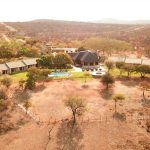
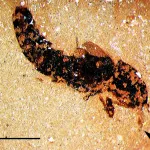








 Become an Insider
Become an Insider
I literally could not bear to read all of this. There seems to be no limit at all to the damage human(un)kind is prepared to inflict on our planet in the name of ‘progress’ and a fast buck. We are not going to learn in time to save our children and grandchildren from total destruction. Morality, ethics, decency and respect vanish faster than the melting ice.